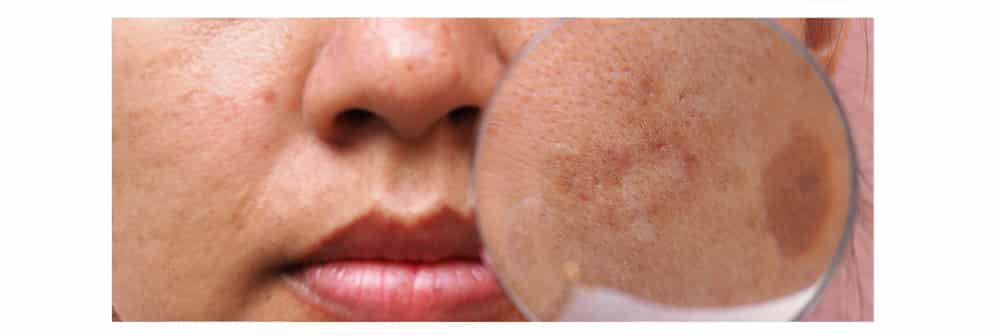At the Collins Cosmetic Clinic one of the commonest problems that we see is patients coming into our medical rooms concerned about brownish discoloration of their skin, what we call Pigmentation. Melanin, which is the naturally occurring pigment produced by our skin, is responsible for the color of our skin and hair. Melanin is produced by pigment cells which are called Melanocytes which are located near the junction of the surface (epidermis) and deeper (dermis) layers of the skin. Most of us have a similar number of pigment cells but what varies between people is how large the pigment cells are and most importantly how much pigment these cells produce.
What Causes Pigmentation?
Some Pigmentation problems are Inherited, which refer to people who are born with areas of more concentrated and overactive pigment cells such as Café au Lait and Naevus of Ota. These fall into the category of Pigmented Birthmarks and these can be significantly improved but typically do require a series of treatments.

Cafe au Lait Birthmark.
Most of the pigmentation problems we see in adults are however what we call Acquired Pigmentation and develop over time as we get older. Various factors can cause Acquired Pigmentation to occur including Hormones, Sun exposure and certain Medications. The UV radiation from excessive sun exposure is the commonest cause of Acquired Pigmentation with the body producing more melanin to protect the DNA of skin cells from ultraviolet radiation damage. Whatever the cause of Pigmentation excess sun exposure and hence UV radiation will aggravate the condition. This means that in all Pigmentation problems the use of sunscreen is important in preventing further pigmentation in the future.
How to get rid of Pigmentation?
There are many treatment options for removing unwanted pigment and different Pigmentation problems require different treatment approaches for the best results. Fortunately, at the Collins Cosmetic Clinic, we have been treating Pigmentation problems for over 20 years and we have a large range of options available, ranging from topical creams to dermal treatments in the clinic such as peels and Laser peels, to the latest Lasers and Devices such as Picotoning. More details on the types of treatments for Pigmentation available at the Collins Cosmetic Clinic can be found on https://collinscosmeticclinic.com.au/concerns/pigmentation/ With the right treatment plan nearly all Pigmentation problems can be treated very effectively.
Which Pigmentation Treatment is best?
The best treatment option depends on the cause of the pigmentation, the severity, your skin type, level of improvement required, and the amount of acceptable downtime. The first step with Pigmentation problems is to make a medical diagnosis of the cause. This involves a thorough history and examination and can involve the use of specialized equipment including Polarized light, Wood’s lamp and Dermoscopy. Some Pigmentation problems such as Brown Spots are fairly easy to treat with often only 1 or 2 Laser treatments needed. Other Pigmentation problems such as Melasma can be difficult to treat and invariably need a multi-faceted approach with a combination of prescription creams, clinic peels and in difficult cases, Lasers as well. Maintenance treatments and long term follow up to control conditions like Melasma are also usually needed.

Sunspot on nose removed with 1 treatment with a small diameter diode laser.
Choice of treatment will vary with the depth of pigment and whether the pigment is localized as in sunspots or generalized and widespread as in Melasma. Generally, more superficial (epidermal) pigment is easier to treat than deeper (dermal) pigment. Localized small areas of Pigmentation can be ‘spot’ treated with a small Laser beam size using a high power, longer pulse to destroy the pigment within the skin cells with heat. Widespread areas of Pigmentation require ‘field’ treatment with a large Laser beam size that uses low power, ultra short pulses to shatter the pigment with an acoustic effect rather than pure heat.

Widespread sun damage on chest before and after 4 treatments with a Diode laser over 6 months

Melasma before and after 4 ultrashort pulse laser treatments combined with daily sunscreen and a prescription topical cream
At the Collins Cosmetic Clinic, we have been treating Pigmentation problems for many years. We are proud of being able to offer a wide range of treatment options for Pigmentation and know that with the right individual treatment plan significant improvements can be achieved. Many Pigmentation problems require maintenance treatments, and a multi-pronged approach is generally the most effective. In nearly all patients with Pigmentation problems sun protection is important. For more information on Pigmentation or if you would like to make an appointment for a consultation feel free to ring our rooms on 03 96545720 or email us on contact@collinscosmeticclinic.com.au













